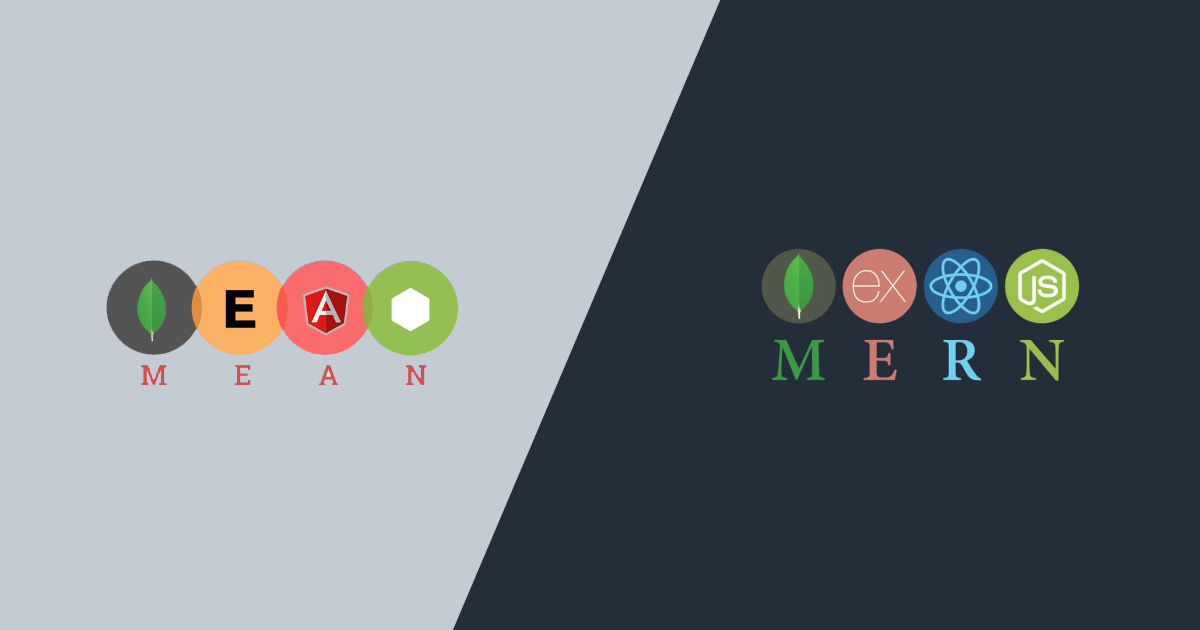How Development Companies Choose The Right Stack When It Comes To MEAN Stack Vs. MERN Stack?

A technology stack is a development process comprising of all the languages and frameworks that go into developing, running and maintaining an application. Two of the most sought-after tech stacks today are the MEAN Stack and the MERN Stack. Let's take some time to understand these technology stacks and find out which one is more preferable for programmers and companies.
Standard features present in both MEAN Stack and MERN Stack
Both MEAN and MERN stacks have similar components including:
M - for MongoDB: Database that stores and retrieves data
E - for ExpressjS: Manages client requests and handles necessary routing and production of APIs
A:AngularJS is a JavaScript framework developed by Google. It provides some awesome features like the two-way data binding.
N -for NodeJS: Manages the creation of backend application on the server-side utilizing Javascript
Basic Comparison between MEAN and MERN Technology Stacks

Angular JS: Used in the MEAN stack, Angular JS has well-defined system architecture, thanks to its MVC framework. This allows the code to be well-organized and therefore, easier to maintain.
However, programmers may find it hard to handle the change events related to large volumes of data owing to its two-way binding model.
ReactJS: on the other hand, is a library, which allows programmers to create dynamic UIs. It features an extensive library of functions and tools utilized to build, as well as render UI components. While organizing data may be a problem because it is just a library, ReactJS allows programmers to handle large volumes of dynamic data on a real-time basis with very few hassles.
Architecture:
MEAN: MEAN features an MVC or MVW architecture that allows programmers to organize codes better. An intermediate layer also helps to separate the UI code from the database, thus making it easier for developers to manage and upgrade existing code.
MERN: Although it facilitates smooth rendering, MERN hands over the responsibility of organizing the code to the developer, which may cause hassles for some developers.
Result: MEAN is a better tech stack when it comes to handling large applications on an enterprise level.
Performance
MEAN: Angular JS provides an excellent MVC framework to organize codes and files.
MERN: React JS helps quicken the coding process owing to its extensive library of Javascript tools to aid developers.
Result: MERN is better in performance.
Productivity:
MEAN: Angular JS comes with a Command Line Interface (CLI) option, which makes it easier for developers to upgrade code. When combined with the stack's MVC framework, this boosts productivity to a great extent.
MERN: While React offers a library for UI building and rendering, it needs the support ofadditional third-party libraries for a fully streamed development process. This makes the MERN stack less productive comparatively.
Result: MEAN is more productive when compared to MERN.
Support for Third-Party Libraries
MEAN: When developing large applications, it is customary for developers to make use of third party libraries. Since Angular JS features an MVC framework, which supports third-party libraries, it becomes easier for developers to use these libraries without any additional configurations or features.
MERN: React JS comes with its library of Javascript tools for app development. However, it does not support additional requests and would need to rely on additional libraries, features and configurations for the same purpose.
Result: The MEAN tech stack's extended support for third-party libraries makes it a better choice for large applications.
Flow of Data
MEAN: Angular JS supports the bidirectional flow of data. Any change in the UI results in an immediate and automatic change to the model state. This makes the MEAN stack more favourable for small projects.
ReactJS: on the other hand, is a library, which allows programmers to create dynamic UIs. It features an extensive library of functions and tools utilized to build, as well as render UI components. While organizing data may be a problem because it is just a library, ReactJS allows programmers to handle large volumes of dynamic data on a real-time basis with very few hassles.
MEAN or MERN: Which is better?

Architecture:
MEAN: MEAN features an MVC or MVW architecture that allows programmers to organize codes better. An intermediate layer also helps to separate the UI code from the database, thus making it easier for developers to manage and upgrade existing code.
MERN: Although it facilitates smooth rendering, MERN hands over the responsibility of organizing the code to the developer, which may cause hassles for some developers.
Result: MEAN is a better tech stack when it comes to handling large applications on an enterprise level.
Performance
MEAN: Angular JS provides an excellent MVC framework to organize codes and files.
MEAN: Angular JS supports the bidirectional flow of data. Any change in the UI results in an immediate and automatic change to the model state. This makes the MEAN stack more favourable for small projects.
MERN: React JS supports the unidirectional flow of data. This means changes to the UI can be made only after making the necessary changes to the model state. This provides a better overview of the flow of data when handling large projects.
Result: MERN stack is considered better when it comes to maintaining the organizational flow of data in large projects.
Support:
MEAN: While both tech stacks provide documentation, the learning curve for Angular JS is comparatively steeper owing to its myriad templates and Typescrips, which need mastering.
MERN: MEAN does not require a learning process and can be easily mastered by developers. It also offers excellent documentation when compared to Angular JS, which makes it easier for developers to master the MERN tech stack easily and quickly.
Result:MERN is better than MEAN when it comes to ease of learning and support for the same
What do Companies Prefer?
Fast and hassle-free web application development from scratch without any gaps or discontinuation in business.
Extensive sharing capabilities, which allow code sharing and reusing over a large platform, thereby reducing overall cost related to building and upgrading code.
Enhanced scalability of MVC architecture framework, which allows developers to build highly scalable applications with ease.
Higher development speed achieved with the help of the myriad libraries, templates and modules available within the stack's framework.
Article Resource:-https://www.eligocs.com/mean-stack-vs-mern-stack/how-development-companies-choose-the-right-stack-when-it-comes-to-mean-stack-vs-mern-stack/
